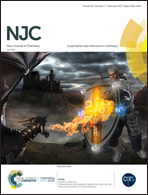Vacuum-dried flexible hydrophobic aerogels using bridged methylsiloxane as reinforcement: performance regulation with alkylorthosilicate or alkyltrimethoxysilane co-precursors†
Abstract
Aerogels are porous materials with many attractive properties, but their large-scale applications are always restricted by the laborious procedures and poor mechanical properties. Herein, a novel monolithic flexible hydrophobic aerogel was prepared using a new type of bridged methylsiloxane as a precursor and tetraethoxysilane (TEOS), methyltrimethoxysilane (MTMS) or propyltrimethoxysilane (PTMS) as co-precursors in a facile and environmentally friendly procedure. The bridged precursor can not only help construct networks of aerogels but also act as an enhancer for its particular molecular structure. The co-precursors TEOS, MTMS, PTMS can tailor the texture and the properties of the aerogels by controlling the hydrolysis and condensation rates and their molecular structures. Co-precursors with faster reaction rates result in smaller particle size in the skeleton and a larger specific surface area. The obtained aerogels are hydrophobic and exhibit good mechanical properties with deformation as high as 80% and low density (0.078 g cm−3). The excellent properties make the aerogels good candidates for oil/water separation.



 Please wait while we load your content...
Please wait while we load your content...